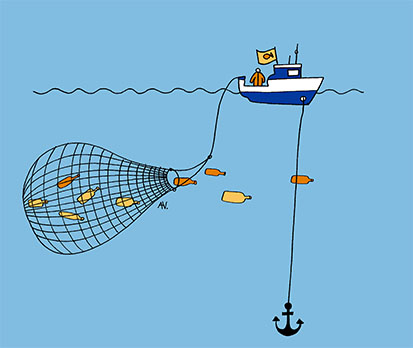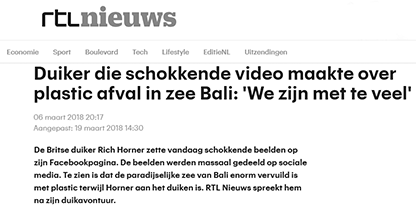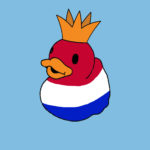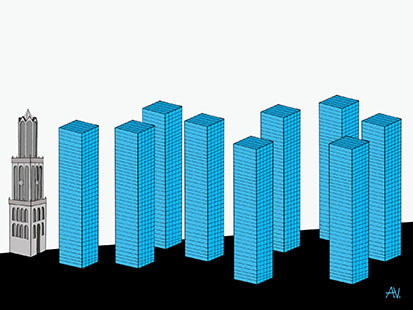How plastic reaches the sea
Plastic can end up in the ocean in all sorts of ways. It can be thrown directly into the ocean, or it can enter the ocean indirectly by being carried via rivers, wind, and waves ¹. It is vital that we understand exactly how, and via which route, the plastic reaches the ocean, because once we know that we can try to control the supply.
Fishery responsible for some of the plastic soup
Some of the plastic in the ocean is caused by plastic dumped or abandoned in the ocean itself. Ships and recreational vessels contribute some of that plastic, but the biggest human source of ocean pollution are fishing and aquaculture.

Did you know… that almost 10% of all ocean pollution comes from fishing?
Scientists estimate that around 10% of all ocean pollution is produced by fishing vessels 6. That is mainly in the form of abandoned or discarded fishing nets and lines, which cause major damage when marine life becomes entangled.
Aquaculture is another source of ocean pollution. Aquaculture is the term for farming fish and shellfish at sea. In the process, ropes, plastic safety equipment, and packaging material can become lost at sea.
Equivalent of 9 Domtorens of waste lost at sea every year
Did you know… that 1,700 containers are lost at sea every year, the equivalent of nine Domtorens.
Shipping also contributes to the plastic soup. In bad weather, some cargo can get washed overboard, and around 1,700 shipping containers are lost at sea each year 7. A standard-size shipping container measures 2.4 by 12 meters. In other words, we could build 9 cathedral towers the size of the Domtoren in Utrecht with all of those containers.
In January 2019, this problem was illustrated when the MSC Zoe lost almost 300 containers (article in Dutch) in a storm off the Dutch coast.
Most of the plastic in the ocean comes from the land
Researchers study the plastic that washes up on shore, so they know that much of the plastic in the ocean actually comes from the land. More than 80% of the plastic they find on beaches consists of packaging material². Since plastic can enter the ocean in so many different ways, it is extremely difficult to control the flow of plastic waste. Before we can do that, we must first know how plastic is carried from the land to the ocean.
What does all of the plastic in the ocean look like?

Watch this video of RTL Nieuws to see the plastic soup from under the ocean.
We know that there is a lot of plastic in the ocean, but we see very little of it here in the Netherlands. The situation is very different in other parts of the world, like the island of Bali, where plastic is a massive problem. This RTL Nieuws video clearly shows how serious the problem of plastic pollution is on tropical reefs. The diver in the video comes across more plastic than swimming fish.
1 UNEP, NOAA (2012) the Honolulu Strategy – A global framework for pre vention and Management of Marine Debris. Retrived from – Website
2 International Coastal Cleanup (2017). Retrived from – Website
3 Kabat, P., Claussen, M., Dirmeyer, P. A., Gash, J. H., de Guenni, L. B., Meybeck, M., … & Lütkemeier, S. (Eds.). (2004). Vegetation, Water, Humans and the Climate: A New Perspective on an Internactive System. Springer Science & Business Media.
4 Williams, A. T., & Simmons, S. L. (1997). Movement patterns of riverine litter. Water, Air, and Soil Pollution, 98(1-2), 119-139.
5 Lebreton, L. M., Greer, S. D., & Borrero, J. C. (2012). Numerical modelling of floating debris in the world’s oceans. Marine Pollution Bulletin, 64(3), 653-661.
6 Macfadyen, G., Huntington, T., & Cappell, R. (2009). Abandoned, lost or otherwise discarded fishing gear (No. 523). Food and Agriculture Organization of the United Nations (FAO).
7 GRID Arendal (2016) Marine Litter vital Graphics. pag. 27 – Website
More interesting info..






